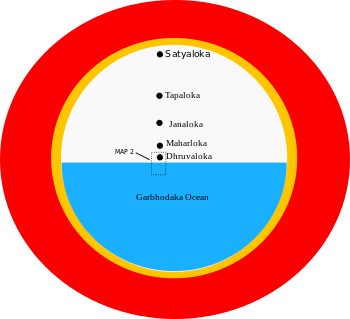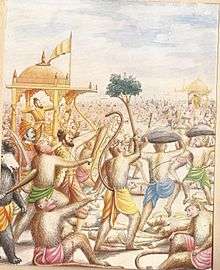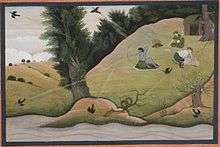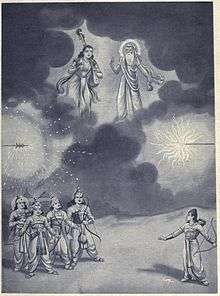Brahmastra
In ancient Sanskrit writings, the Brahmastra (Sanskrit: ब्रह्मास्त्र, IAST: Brahmāstra) and its variants the Brahmashirsha astra and the Brahmanda astra were supernatural weapons used in various Hindu mythological wars and are collectively called Brahma weapons. The Brahmashirsha astra was a weapon that could destroy the world. These weapons are all from Lord Brahma.
The three weapons are commonly called brahmastra by the various versions of the Mahabharata,Ramayana and the Puranas.As described in a number of Purana, it is considered a very destructive weapon.The Brahmastra never missed its mark and had to be used with very specific intent against an individual enemy or army, as the target would face complete annihilation. It was believed to be obtained by meditating upon the Lord Brahma, or from a Guru who knew the invocations. According to ancient Sanskrit writings, the Brahmastra is invoked by a key phrase or invocation that is bestowed upon the user when given this weapon. The user would have to display immense mental concentration.
Since Lord Brahma is considered the Creator of Sanatana Dharma, it is believed by Hindus that Brahmastra was created by Him for the purpose of upholding Dharma and Satya, to be used by anyone who wished to destroy an enemy who would also happen to be a part of his (Brahma's) creation. The target, when hit by Brahmastra, would be utterly destroyed.[1]
It is termed as a fiery weapon that created a fireball able to threaten the world with destruction.[2] There was also a severe decrease in rainfall with the land developing cracks, as in a drought. The Brahmastra is mentioned in the epics and Vedas as a weapon of last resort and was never to be used in combat.
The Brahmastra, described in the Mahabharata, is a weapon which is said to be a single projectile charged with all the power of the universe.
Brahmashirsha Astra
The Brahmashirsha Astra(Brahma's head missile)[3] literally the fifth head of brahma[4] is a weapon that manifests with the fifth head of brahma at its tip. It is a weapon that was capable of destroying the world.[5] Arjuna and Ashwatthama used the astra against each other at the end of the kurukshetra war.
Brahmanda Astra

The Brahmanda Astra is an ultimate weapon that is able to destroy the universe consisting of the three worlds (patala, prithvi, swarga).[6]It is the most powerful of the Brahma weapons in Hindu mythology.
Brahmadanda
The Brahmadanda is the rod of Brahma and the countermeasure to all astras, but it also commonly referred to the bamboo rods carried by Indian ascetics.[7]It possessed the ability to neutralize any astra that was used against it.The brahmadanda is first mentioned in the Ramayana where Viswanath uses every Astra he had obtained only for them all to be absorbed and neutralized. The brahmadanda is used again in the saturudra samhita of the Shiva Purana by the sage Pippalada against the god Shani and makes the latter pledge to never harm anyone below the age of 12.
Uses


There are numerous instances within Sanskrit scriptures where the Brahmastra is used or its use is threatened, including:
- Maharaja Kaushika (who later became Brahmarshi Vishvamitra) used it against Maharishi Vasishta, but the Brahmastra was swallowed by Vasishta's Brahmanda Astra.
- Indrajit used the nagasthira against the army of Rama in the Ramayana. Laxmana was felled by the weapon. Only the sanjeevani herb brought by Hanuman saved the brothers and their army. Also, Indrajit used the Brahmastra against Hanuman, but Hanuman survived because of boon previously given to him by Lord Brahma.
- In the Ramayana, a Brahmastra is used by Shri Rama several times: once against Jayanta when he hurt Sita, against Mareecha in their last encounter, and finally the Brahmastra was used in the last battle with the Asura emperor Ravana.[8] According to the Ramayana, the weapon was also aimed at Varuna to carve a path out of the sea such that Rama's army could march towards the island of Lanka. However, as Rama loaded the weapon, Varuna appeared and offered to assist the king in crossing the ocean. But once invoked, the Brahmastra must be discharged, and hence it was instead aimed towards Dhrumatulya, falling at of modern-day Rajasthan, causing it to become a desert for aeons to come. However, this incidence is not mentioned in the critical edition of Valmiki Ramayana.
See also
References
- ↑ http://www.sacred-texts.com/hin/m10/m10012.htm
- ↑ Krishnamoorthy, K.; Channakeshava, B.; Rao, H. V. Nagaraja (1995). Ānanda Bhāratī: Dr. K. Krishnamoorthy Felicitation Volume. Dr. K. Krishnamoorthy Felicitation Committee.
- ↑ Maehle, Gregor (2009). Ashtanga Yoga: Mythology, Anatomy, and Practice. New World Library. ISBN 9781577316695.
- ↑ "Brahmaśiras - Oxford Reference". doi:10.1093/acref/9780198610250.001.0001/acref-9780198610250-e-542.
- ↑ "The Mahabharata, Book 10: Sauptika Parva: Section 12". www.sacred-texts.com.
- ↑ The Matsya Puranam. Pâṇiṇi Office. 1916.
- ↑ The Rāmāyaṇa of Vālmīki: An Epic of Ancient India, Volume VII: Uttarakāṇḍa. Princeton University Press. 2016. ISBN 9781400884568.
- ↑ Gopal, Madan (1990). K.S. Gautam, ed. India through the ages. Publication Division, Ministry of Information and Broadcasting, Government of India. p. 80.

